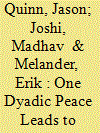| Srl | Item |
| 1 |
ID:
179220


|
|
|
|
|
| Summary/Abstract |
This paper uses analysis of the combat practice by opposing parties in the Syrian conflict as the basis to suggest and justify some new development trends in the methods of combined-arms combat (operation).
|
|
|
|
|
|
|
|
|
|
|
|
|
|
|
|
| 2 |
ID:
180779


|
|
|
|
|
| Summary/Abstract |
This concludes an article in the previous issue of Military Thought.1 Relying on an analysis of combat actions by the opposing sides in the Syrian military conflict, this paper proposes and substantiates certain new trends in the development of combined-arms combat action (operation) methods.
|
|
|
|
|
|
|
|
|
|
|
|
|
|
|
|
| 3 |
ID:
170009


|
|
|
|
|
| Summary/Abstract |
Governments often fight multiple civil conflicts simultaneously and each conflict can have multiple groups. Prior research on civil war termination and recurrence has been conducted at either the conflict level, once all the groups have been terminated, or the dyadic level, which examines group terminations in a conflict separately as more or less independent processes. Hence, conflict-level studies mostly tell us how to preserve peace once a civil war has already ended, while dyadic studies mostly tell us about the durability of specific group-level terminations within the larger process that led to that ending. As a result, our understanding of how ongoing civil wars are brought to a close is limited, particularly, with respect to multiparty conflicts. In this study, we put forth a systems approach that treats dyadic terminations as connected processes where group terminations influence the future behavior of other groups, incentivizing the system toward greater aggregate peace or conflict. Analyzing 264 dyadic terminations, the findings suggest that the most effective strategy for governments to reduce systemic conflict is to demonstrate to other groups that they have the political will and capacity to implement security, political, and social reforms as part of a larger reform-oriented peace process. Viable implementation can be followed by the concomitant use of military victories against remaining groups with great success. However, military victories achieved in isolation, that is, outside of a reform-process, do not reduce future levels of conflict even if they themselves are durable.
|
|
|
|
|
|
|
|
|
|
|
|
|
|
|
|